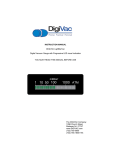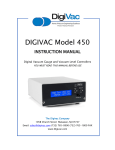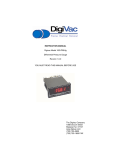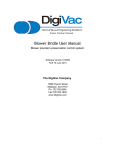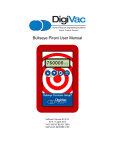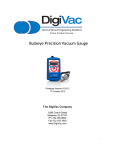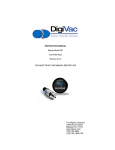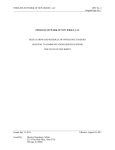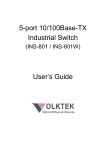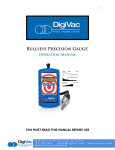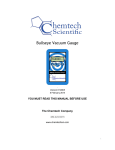Download Model 801V WCE Instruction Manual
Transcript
INSTRUCTION MANUAL DIGIVAC Model 801 Series Digital Vacuum Gauge 801W 801W Ranges .001 to 760 Torr 1 to 9999 microns .001 to 999 millibar YOU MUST READ THIS MANUAL BEFORE USE The DigiVac Company 105B Church Street Matawan, NJ 07747 Ph: 732.765.0900 Fax: 732.765.1800 www.DigiVac.com CONTENTS 1.0 Description and Principle of Operation 2.0 Construction 3.0 Unpacking and Inspection 4.0 Installation 5.0 Operation 6.0 Servicing, Maintenance and Calibration 6.1 Factory Repair and Calibration 6.2 Field Calibration 7.0 Notes on Calibration 8.0 Understanding Torr 9.0 Accessories and Modifications 10.0 Attachments, Illustrations and Specifications 11.0 Terms and Conditions 2 1.0 DESCRIPTION AND PRINCIPLE OF OPERATION. The DIGIVAC 801 series gauge is a compact digital vacuum sensing instrument. It uses a thermocouple gauge tube to sense vacuum and display the reading in either milliTorr or mbar. The DigiVac Model 801 can be panel mounted using the same cutout and hole mounting pattern of a traditional Varian 801 pointer meter gauge. Consult the DigiVac website www.DigiVac.com for information about other DigiVac vacuum controllers and gauges. The DigiVac Model 801 operates by measuring the temperature rise of an electrically heated thermocouple exposed to a vacuum. As vacuum increases, or more correctly, as absolute pressure decreases, fewer and fewer molecules of gas are available to cool the thermocouple. With less molecules the air temperature rises and the thermocouple gauge thus senses the vacuum. A precision reference inside the DigiVac in conjunction with an integrated circuit amplifier controls the electrical excitation of the sensor filament. The voltage response of the thermocouple is piped through a CPU and is translated to the current vacuum reading. 2.0 CONSTRUCTION The 801 consists of the indicating and controlling instrument, the gauge tube, the gauge tube cable, AC power supply, and if so equipped also has interfaces for the 2 control connections, analog out, and RS232. The gauge tube houses the various thermocouple sensing, heating and compensating elements and terminates in an octal connector. On this model, the connector wiring terminates at the instrument with a 6 position RJ24. Regulating circuitry in the DigiVac provides proper current for gauge tube excitation, and thus compensates for resistance in the probe leads. 3.0 UNPACKING AND INSPECTION After the DIGIVAC is received, it should be carefully unpacked and inspected for damage during shipment and for completeness. In the event of a loss during shipment, a claim should immediately be made to the common carrier or the postal service, as applicable. The DigiVac warranty pertains only to the instrument, and does not cover losses in shipping. Each 801 should come with: Display controller AC Power supply with AC wiring adapter Gauge Tube Cable Varian 531 gauge tube Mounting Hardware If ordered with additional options, it will also come with: 3 AC power supply with international adapters (instead of above) 5V5T analog recorder terminal connector RS232 DB9 connector Terminal connector for U and L relays 4.0 INSTALLATION The instrument should be located in a clean, dry environment for best results. The unit can be panel mounted with the hardware provided: • • • • Remove the front panel of the gauge, leaving the aluminum spacers on the gauge printed circuit board. Make a 2.66" circular mounting hole in the panel at the desired location Make 3 or 4 holes, 5/32" diameter (clearance holes for #4 screws) on a 1.58 radius from the center of the mounting hole. (The front panel that comes with the gauge can be used as a template.) Reassemble the gauge, with the plastic panel outside, and the gauge behind. The gauge tube cable should be identified by wire tags or markings specific to your environment. Thermocouple gauge tubes must be installed in a thread-down orientation in a clean, dry vacuum system. While threading the gauge tube in to the manifold, the gauge tube cable should be disconnected to avoid damage. In this way, twisting of the cable and the octal socket on the tube is avoided. Care should be exercised to install the tubes in a dry part of the system. Since the instrument works on the principle of temperature rise, the probes will not work if they become filled with a liquid such as vacuum or diffusion pump oil. The gauge tube should be protected against oil and other contaminants by installing it in such a way to protect it. A good practice is to mount the gauge tube in the most vertically distant place from oil and other contaminants as applicable. The gauge tube should be mounted in the most stable pressure region of the vessel to be measured. For example, it would be better to install the gauge tube on a tank rather than on the pipe that is directly connected to a vacuum pump. In the event of contamination, see section 6.0 for gauge tube cleaning instructions. If the gauge is used in a Neon sign processing facility, the following is recommended to protect the gauge from bombarding damage: The gauge tube should be isolated from the system with a stopcock. The stopcock should be closed when bombarding. There should be at least 2 feet of tubing between the electrode and the Instrument. For best results, the tubing should be metal. In extreme cases, the gauge can be absolutely protected by installing a normally open solenoid valve between the gauge tube and the system. The solenoid valve coil should be in parallel with the bombarding transformer. In this way, the solenoid will be closed and the gauge tube will be positively protected whenever bombarding is done. If a gauge is damaged by bombarding, it can generally be brought back to operating condition by replacing the Op amp which controls the gauge tube current. Consult DigiVac. 4 The set point connections are in the back of the unit. There is one row of pins with a terminal strip connector for the 2 set point connections. The set point connections are in the order: 1. Common – The common line of a switch 2. N.C. – Normally closed. This means that above the set point value there is a current path between the common and the N.C. terminal. Put another way the switch is “ON” between these 2 terminals. At the set point value and below (higher vacuum, lower pressure) the connection is open. Put another way, the switch is “OFF” between the common and the N.C. connection at higher vacuum (a lower pressure reading). 3. N.O. – Normally open. This means that above the set point value there is no current path between the common and N.O. connection. Put another way the switch is “OFF” between these 2 terminals. When the vacuum indication goes below the set point value (higher vacuum, lower pressure) the current path closes. Put another way the switch is “ON” between the common and N.O. connections at absolute pressure readings below the set point value. Take care to insure that the wire connections are made fast, and the voltage and current does not exceed 250V or 7A. If you need to control a device that draws more power, consider another relay in between the DigiVac output and the device to be controlled The Analog output is located in the center of the back panel, and should be connected to a high impedance input. The output impedance is 1KΩ. The RS232 connection can be made to a PLC or computer via a male DB9 cable connection to the female DB9 connection on the DigiVac. The DigiVac acts as a DCE, so a straight serial connection is appropriate. Please use the supplied 5V AC adapter with your Instrument. This adapter provides clean short protected power to protect and insure proper functioning of the internal circuitry. 5.0 OPERATION After installation, the Instrument is ready for immediate operation. The unit will normally provide accurate readings immediately however, occasionally a gauge tube will have absorbed material during storage, and may require as much as 24 hours of operation before accurate readings are attained. It is recommended that the DIGIVAC be energized continuously during vacuum system operation. In this way, the hot filament will not allow contaminants to condense. In cases where the system has contaminants, as is often the case with metalizing and coating equipment, it is often effective to isolate the gauge tube with a solenoid or manual valve during periods when contamination is most active. 5 The DigiVac 801 has 2 set points that can be used to actuate external equipment. These 2 set points can be adjusted from the front of the gauge in your currently selected units. 1. To change SP1: a. Press the “U” button- set point 1 will be displayed b. Turn the “SP1” or the left most potentiometer when looking at the front face of the 801 to adjust set point 1 to the desired level 2. To change SP2: a. Press the “L” button- set point 2 will be displayed b. Turn the “SP2” or the right most potentiometer when looking at the front face of the 801 to adjust set point 2 to the desired level 3. If you don’t want the set points to actuate at all, set the set point for “000”. The Instrument has additional outputs which can be used: RS232 – The instrument puts out a standard RS232 serial stream with settings 9600, 8, N, and 1. The unit transmits but does not receive, and displays the current vacuum indication in the current units. Analog out – This output reads from 0 to 5 Volts from a pressure of 1 micron all the way up to 5 Torr. There is a graduation of 1 milliVolt per milliTorr. Therefore, 10 milliVolts = 10 milliTorr, and 4 Volts = 4 Torr. 6.0 SERVICING AND MAINTENANCE GAUGE TUBE SERVICING In many cases, a gauge tube may become fouled with oil or other foreign matter. It is often possible to restore the functionality of contaminated probes with cleaning. If the contaminant is known, the tube should be filled with a fluid that is known to be a solvent to that contaminant. As an example, ether is often effective in removing residues of some oils. Commercial carburetor cleaners are very powerful solvents and are highly effective against some contaminants. After cleaning with solvents, the gauge tube should be completely dried or flushed with a volatile solvent to assure that it is dry prior to re-installing it. If this is not done, contamination of the system may result. MAINTENANCE Your vacuum instrument should give you many years of trouble free service. There are no regularly scheduled maintenance intervals. If consistent accuracy is required, it is recommended that the gauge, tube, cable and power supply be returned for a yearly calibration check. 6.1 FACTORY REPAIR AND CALIBRATION 6 The vacuum gauge assembly is designed to provide years of trouble-free service, and the liberal internal use of plug-in components make it easily repairable. No field servicing of the unit is recommended, other than replacement of the gauge tube, but factory servicing and calibration are available at a nominal cost and fast turn-around times. 6.2 FIELD CALIBRATION Each DigiVac vacuum gauge controller is calibrated to the particular vacuum gauge sensor that is shipped with the unit. While changing the gauge tube is possible, it will result in a slightly different reading as all gauge tubes are not created equal. Although it is preferable that all calibration be performed at DigiVac, field calibration can be accomplished. Before re-calibrating the instrument, it should be ascertained that the instrument is in fact incorrect. In many cases, the problem will be with a tube that is fouled, or a system that is operating improperly. It is recommended that a spare tube be kept on hand and stored in a clean, dry place. Then, in cases of suspect readings, the tube should be changed before proceeding further. If adjustments are to be made, proceed as follows: A) Remove the Instrument from the panel. B) The “Zero” potentiometer is at the top center just below the top mounting hole as you look at the LED Display, the “ATM” or span adjust is to the left on the back of the board on the same side as the sensor RJ connector. C) Operate the vacuum system at the lowest attainable pressure, and allow the system and the gauge tube to stabilize for several minutes. Factory zero setting is done at a pressure of .1 milliTorr (.1 micron) or less. D) Adjust the zero setting potentiometer so the unit reads zero. Make sure not to under span. Allow the measurement standard to rise to 1 milliTorr and make sure the gauge reading also reads 1 milliTorr. E) Check the operation of the gauge at other pressures. Normally, slight adjustments of the zero will not be interactive with the readings of the instrument at higher pressures. F) The ATM adjustment is normally not necessary. If necessary, adjust the span with the ATM potentiometer. a. Set the vacuum level to Atmosphere (approximately 760 Torr) and slowly turn the potentiometer on the right until the DigiVac gauge reads 760 Torr, being careful not to over span. b. If you adjust the span, recheck the zero, then the span, and the zero one last time. 7.0 NOTES ON CALIBRATION The instrument is calibrated in nitrogen, which has thermal properties virtually identical to air. Other gasses will affect the readings by an amount proportional to the thermal conductivity of the gases. In most cases, the gases present in a vacuum system will be air, nitrogen, or oxygen, and no appreciable errors will occur. 7 Certain other gases, however, have thermal conductivity significantly greater than air and will cause the instrument to read higher than the actual amount of pressure. Examples of such gasses are water vapor, fluorocarbon refrigerants, and acetone. Conversely, other gasses have thermal conductivity significantly lower than air and will cause the instrument to read lower than actual pressure. Examples of such gasses include helium, oxygen and to a lesser extent, CO2. When interpreting readings using gasses other than air, it should be borne in mind that the DIGIVAC reads Torr, which is a measure of absolute pressure - that is the opposite of vacuum. Thus, a lower numerical reading actually is a higher level of vacuum. For more information, refer to section 8.0. When in doubt, consult DigiVac. 8.0 UNDERSTANDING TORR The DIGIVAC and many similar instruments are calibrated in microns or "milliTorr." It is appropriate to discuss what microns are and to relate microns to other measures of pressure and vacuum. Microns are not really a measure of vacuum at all, but rather of absolute pressure. It will be recalled that the pressure of the atmosphere is 14.696 or approximately 14.7 pounds per square inch at sea level. This pressure is due to the weight of all of the air in the earth's atmosphere above any particular square inch. This 14.696 psi is equivalent to the pressure produced by a mercury column of approximately 29.92 inches high or .76 meters (about 3/4 of a yard) or 760 millimeters of mercury. Atmospheric pressure varies greatly with altitude. It decreases approximately 1 inch of mercury per thousand feet of altitude. It also varies widely with local weather conditions. (Variations of one half inch in a single day are common.) The word vacuum means pressure lower than atmospheric or "suction," but, in describing negative pressure, the atmosphere is only a satisfactory reference if we are dealing with values of vacuum down to about 27 inches of mercury. Below that, it is much more useful to talk in terms of absolute pressure, starting from absolute zero. The 801 and all similar instruments do just this. One TORR, a commonly used unit, is an absolute pressure of one millimeter of mercury. A milliTorr is equal to one thousandth of a TORR. A MICRON is the same as a milliTorr. 9.0 ACCESSORIES AND MODIFICATIONS Please consult the product guide and website for the latest available accessories. We also offer analog output, RS232 and 2 set point controls as production options to the 801W. SPECIAL REQUIREMENTS It is the policy of the DigiVac Company to customize instruments for specialized requirements whenever it is economically feasible to do so. We encourage inquiries about your special needs. 8 10.0 10.0 SPECIFICATIONS Input Voltage Voltage 0.5A at 5VDC Maximum Relay Voltage and Current 250VAC at 7 Amps Recommended wire gauge for analog and set point wiring 1414-28 AWG Maintenance Interval 1-10 years depending on use Overall Dimensions, Dimensions, front panel 4.0 in wide, 3.5 in high, 1.4 in deep Panel Cutout Dimensions 2.66 inch diameter cutout Ambient Operating range 0°C to 70° 70°C Measurement Media Clean Dry Air or Nitrogen There may be impairment to the protection of the equipment if it is used in a manner that is not specified. Instrument Accuracy: .001 to .010 Torr +/+/- .001 Torr .010 to 2.00 Torr +/+/- 10% of reading 2.0 to 160 Torr +/+/- 50% of reading 160 to 760 Torr +/+/- 25% of reading For repair or recalibration, return gauges to: The DigiVac Company 105B Church Street Matawan, NJ 07747 Ph: Fax: 732.765.0900 732.765.1800 E-mail: Direct from our website www.DigiVac www.DigiVac.com DigiVac.com The DigiVac Company manufactures a complete line of vacuum gauges and process computers. Contact us or your distributor if you wish for further information. See www.DigiVac.com for our latest offerings 9 11.0 TERMS AND CONDITIONS . TERMS OF USE, LIMITED WARRANTY & LIABILITY WAIVER THE DIGIVAC COMPANY (“DigiVac”) offers all of its products with the following terms and conditions and notices as follows. By accepting and/or using a DigiVac product, you hereby acknowledge and agree to the following terms and conditions, and acceptance of these terms and conditions are a condition precedent to any purchase/sale agreement between you and DigiVac. EXCLUSIVE OBLIGATION: The DigiVac product you are purchasing has been designed for a specific use within a set of suitable operating conditions, as set forth in its User Manual, or as indicated otherwise by DigiVac. Any use of the DigiVac Product for any purpose or under any conditions, other than those specified, shall render any limited warranty void, and shall expressly invalidate any liability of DigiVac for damages as a result of such misuse. USER LIMITATION: You may not modify, copy, distribute, transmit, display, perform, reproduce, publish, license, create derivative works from, transfer, or sell, any information, software, products or services obtained from or created by DigiVac to any third party, without the express written consent of DigiVac to do otherwise. Any violation of this provision shall give rise to an indemnification of DigiVac by you, for any third party claims arising out of such violation. THIRTY (30) DAY LIMITED WARRANTY: All DigiVac products are warranted against any manufactured defect for a period of thirty (30) days from date of purchase, unless such product is a custom-work for you and not a standard DigiVac product. Any product qualifying as a custom-work shall not be warranted against any defects for any purpose, and your acceptance of such custom-work shall relieve DigiVac of any liability for any purpose. WITH THE EXCEPTION OF THE LIMITED WARRRANTY ABOVE, YOU AGREE ANY DIGIVAC PRODUCT IS PROVIDED AS IS, EXCLUSIVE OF ANY WARRANTY, INCLUDING, WITHOUT LIMITATION, ANY IMPLIED WARRANTY OF MERCHANTABILITY, FITNESS FOR A PARTICULAR PURPOSE, NON-INFRINGEMENT, OR ANY OTHER WARRANTY, EXPRESSED OR IMPLIED. LIMITATION OF LIABILITY: You agree and acknowledge, DigiVac shall have no liability to you whatsoever for any direct, indirect, punitive, incidental, special consequential damages arising out of or connected with the use or misuse of its products. In particular, given the nature of DigiVac products, you agree and acknowledge, under no circumstances whatsoever shall DigiVac be liable to you for any consequential damages for damage to any non-DigiVac product or service, arising from the failure, use or misuse of a DigiVac product, including, but not limited to, any vacuum system, engine, vehicle, factory, or the like. In the event, a court of law with proper jurisdiction finds DigiVac liable to you for any purpose, you agree and acknowledge DigiVac’s maximum liability shall not exceed the purchase price of one unit of product giving rise to such liability, or $250.00, whichever is greater. ENTIRE OBLIGATION: These terms and conditions express the entire obligation of DigiVac with respect to its products. If any part of these terms and conditions are deemed void, invalid, unenforceable or illegal, including, but not limited to, the warranty disclaimers, liability disclaimers and liability limitations set forth above, then the unenforceable clause or sentence may be disregarded with the remainder of these terms and conditions valid and enforced. In the event the unenforceable clause or sentence leaves a void in these terms and conditions, a provision closely matching the intent of the unenforceable provision should be deemed inherent within these terms and conditions, slightly modified to render such provision valid and enforceable. GENERAL: These terms and conditions are governed by the laws of the State of New Jersey, USA. You hereby consent to the exclusive jurisdiction and venue of the Courts of New Jersey, in all disputes arising out of or relating to the use of this product. Use of this product is unauthorized in any jurisdiction that does not give effect to all provisions of these terms and conditions. MODIFICATION OF TERMS AND CONDITIONS: DigiVac reserves the right to change the terms, conditions, and notices under which their products are offered. 10










